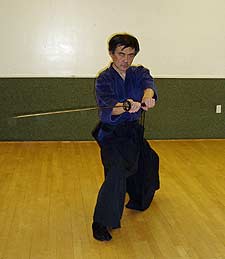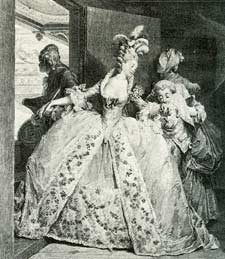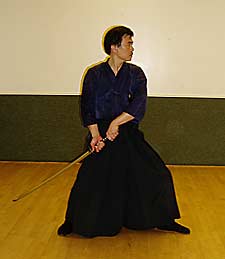Tradition in Motion:
Aesthetic Movement in Japanese Dance and Swordsmanship
– Part 1
By Deborah Klens-Bigman, Ph.D.

Some years ago, I came across a photo published in Dragon
Times (a martial arts publication specializing in traditional karate):
a teacher from Japan visited a US karate dojo. The guest was seated center
front, surrounded by his American hosts. He sat in seiza, the traditional,
formal kneeling posture. His hosts attempted to do likewise, but unlike
the Japanese sensei, they sat with knees far apart, arms akimbo (elbows
sticking out), keikogi (uniform top) askew. The photo was about more than
size differences; it was about differences in movement and deportment.
As the photo illustrated, Americans and Japanese have different approaches
to movement, especially apparent when it comes to traditional Japanese
art forms. This paper will briefly explore some of the use of the body
in traditional Japanese arts. I will draw examples from iaido and iaijutsu
- the sword-drawing arts - and Nihon Buyo - the Japanese classical dance,
also called Nichibu.
To begin with, we should dispel any notion that differences in the use
of the body can be attributed to some vague idea of "culture"
that "cannot be learned or understood by outsiders." This was
a familiar trope when I was in grad school and I am happy to say I did
my best at the time to help dispel it. One of my professors also used
to turn this notion on its head: we would never say a Japanese woman could
not be a ballerina because she was not capable of learning a highly Western-enculturated
set of movements. All the same I still encounter people who insist that
"only women can sit in tatehiza" (a half seated, half-kneeling
position) or that it is somehow unnecessary to learn proper deportment
as part of traditional training. On the other extreme, we can also find
teachers who offer "traditional training" courses in some dance
or martial art form that only lasts six weeks (or less). Like the traditional
art form itself, the accompanying ways of moving take years to learn,
and even longer to really understand, but, like the Japanese ballerina,
it can be done.
The fact is, in spite of size and age and culture, humans perform certain
rudimentary movements in pretty similar ways. For example, we all learn
to walk upright even though old, young, tall, short, fat, thin all produce
an endless variety of ways of walking. How we walk depends on physical
characteristics, but also on culture. Culture is learned, and changes
over time. However, we do have a tendency to view our own ways of moving
as somehow eternal and unchanging. Moreover, we consider the traditional
ways that other people move as, well, different, and somehow unknowable
- which is not true, of course. Let's look at an example from the European
and American Colonial past.
 |
An engraving of a French woman
in a dress with very wide paniers, c. 1777 (note she has to enter
the room sideways.)
(in Laver, n.d.: 144) |
Women in 18th century America and Europe wore skirts with great wide
side panels called paniers. When I was a kid and visited Colonial Williamsburg,
I was fascinated by these outfits. Unlike hoop skirts, which were from
a later era and somehow more familiar (from watching the movie Gone with
the Wind, or maybe just seeing older girls' prom dresses?), paniers were
wide from side to side and dropped straight down in front and back. A
corset ensured that no unseemly bending at the waist would ruin the effect.
What I didn't realize until years later was that walking in a panier
was not like how we walk today. If one walked with one's knees moving
forward, they would protrude and ruin the line of the dress. Likewise
for sitting down. The solution was to walk with one's knees out to the
sides and to sit with knees splayed in a way that would have shocked anyone
wearing a late 19th century tubular bustle-gown, let alone someone in
a '60's A-line skirt. But to an 18th century woman there was nothing strange
about it. Likewise a man in breeches and a frock coat and court-heeled
shoes would not walk like a modern office worker, let alone a sneaker-wearing,
baggy-panted teenager (in fact, men's turned-out stances where at least
somewhat like the women's). Would-be hip-hop artists walk differently
than secretaries. Ballet dancers turn out their feet (like women in paniers,
on whom their style of movement is partially based). Get it?
Okay, so what does this have to do with our topic, except to say that
we can work our own version of enculturation when it comes to learning
martial arts. Understanding traditional movement can help deepen our understanding
of what it is we are trying to do, how the movement works and why.
For all of its ubiquity (martial arts is all about movement, obviously),
there is a great deal of misunderstanding regarding traditional movement
for martial arts. One of the arguments I have heard has to do with performing
sword kata from seiza. Numerous people have pointed out that seiza is
an indoor posture, samurai were required to leave their long swords outside,
so doing long sword forms from seiza is not logical. However, according
to Tsumaki Kazuo, Fuku Soke (Assistant Headmaster) of Tamiya Ryu Iaijutsu,
practicing forms from seiza was simply a derivation from practicing in
sonkyo or similar crouching positions assumed when wearing armor (Alexanian
2006, n.p.).
The outdoor/indoor argument is therefore not relevant. In my opinion
(shared by several others), seiza is also a pedagogical device. Moving
from seiza strengthens the quadriceps and lower back. More importantly
it is a relatively safe way to learn beginning technique with what is
a potentially dangerous weapon. Lastly, seiza shows respect: to the teacher,
the dojo and the art form itself.
The next argument is what I call the "weirdness factor." Traditional
movement is generally so alien to anyone not involved in it that, failing
to understand it at first blush, it is deemed irrelevant. Combine this
with the amazing predisposition of some Americas who think that they can
improve anything they come in contact with, and the result is people who
refuse to buy in to the idea that the examples I am about to mention will
improve their training. As my colleague Peter Boylan has stated, in modern
budo, you can shape the practice to yourself (hence exhibitions that endlessly
combine effective movement with show-biz flash). In koryu budo (classical
martial arts of Japan before the modern era), you shape yourself to the
art. The persistence of koryu practices over time is evidence that people
can, and do, shape themselves to the art.
The use of the body in both classical Japanese dance and iaido is mostly
descended from the Edo period, (1603-1868) and it is still preserved in
current practice of these art forms. I am not considering more modern
arts, such as kendo, which developed in the late 19th-early 20th centuries.
At that point, Western style movement had already gained a foothold, thanks
to the craze for things Western during the Meiji Period. Put an iaidoka
and a kendoka together to do a similar form or exercise and the difference
should be apparent right away.
In modern Japan, people move for the most part like people in Western
societies. Clothing is basically the same, for example, as are most modern
home furnishings, so styles of movement are similar. Still, there are
some differences. Adults tend to slouch less. People are generally thinner.
Japanese people swing their arms less when they walk, and there seems
to be less emphasis on putting the heel down first when taking a step.
Men sitting on the subway cross their legs at the knee, European-style,
which American men virtually never do. A middle-aged woman stepping on
to a bus in Tokyo will turn in her foot; a habit that has to do with wearing
kimono (that her daughter may not have needed to pick up).
It should be noted that, unless he was raised in a traditional household
(increasingly unlikely today) a Japanese person will have almost as much
trouble with the traditional seated postures of seiza or tatehiza as an
American, though he will probably understand them better. Moreover he
will not see sitting in seiza as particularly strange, but maybe as old-fashioned
(which it is).
The antiquated style of movement associated with Japanese swordsmanship
is part of what a colleague of mine has referred to in his college lectures
as "seiza bunka" - literally, "kneeling culture."
Seiza bunka is broader than just traditional martial arts, of course,
and includes any art form that developed during the Edo Period, including
tea, calligraphy, classical dance and flower-arranging. This is why some
very traditionally-oriented martial arts teachers will suggest an additional
cultural pursuit besides iaido or iaijutsu - the cultural activities complement
and inform each other, not just in aesthetics or broader concepts, but
in deportment as well.
We can begin with looking at some basic kamae, or positions, for iai.
The basic kamae is seigan no kamae, a sort of "en garde" posture.
In seigan, the right hand is topmost on the tsuka (grip) and the right
foot is advanced.
|
|
In jodan, the sword is held above
the head, making the left hand foremost, and the left foot is
advanced.
|
|
|
In migi hasso, the left hand is
also foremost and the left foot is advanced.
|
|
|
In gedan, the right arm is foremost,
and the right foot is advanced. |
In migi wakigamae, the left hand
is foremost and the left foot is advanced. |
 While
there are exceptions, we can see an emphasis of the same hand and foot
being advanced in kamae (position). It seems pretty obvious to any iaidoka
- when the sword is swung for a cut, the body should move in harmony with,
and not in opposition to, the sword. To do otherwise is to invite potential
disaster as the sword would get closer to an opposite limb than it would
if foot and sword move together on the same side of the body. Additionally,
putting body weight behind the weapon will make it easier to use. While
there are exceptions, we can see an emphasis of the same hand and foot
being advanced in kamae (position). It seems pretty obvious to any iaidoka
- when the sword is swung for a cut, the body should move in harmony with,
and not in opposition to, the sword. To do otherwise is to invite potential
disaster as the sword would get closer to an opposite limb than it would
if foot and sword move together on the same side of the body. Additionally,
putting body weight behind the weapon will make it easier to use.
And yet this is very difficult for American beginners in iaido to grasp.
I believe it is because we are trained in everyday life to move arms and
legs in opposition. We take our opposition arms and heel-toe movement
seriously. Walk down any crowded city street and see how many times you
have to avoid (or end up getting hit by) a swinging arm, sometimes attached
to a shopping bag or briefcase. Live a floor below an uncarpeted apartment
and you can hear the heels hitting the floor as your upstairs neighbor
walks about.
About The Author:
Deborah Klens-Bigman is Manager and Associate Instructor of iaido at
New York Budokai in New York City. She has also studied, to varying extents,
kendo, jodo (short staff), kyudo (archery) and naginata (halberd). She
received her Ph.D in 1995 from New York University's Department of Performance
Studies where she wrote her dissertation on Japanese classical dance (Nihon
Buyo). and she continues to study Nihon Buyo with Fujima Nishiki at the
Ichifuji-kai Dance Association. Her article on the application of performance
theory to Japanese martial arts appeared in the Journal of Asian Martial
Arts in the summer of 1999. She is married to artist Vernon Bigman. For
FightingArts.com she is Associate Editor for Japanese Culture/Sword Arts.
|